AQS原理分析
什么是AQS
java.util.concurrent包中的大多数同步器实现都是围绕着共同的基础行为,比如等待队列、条件队列、独占获取、共享获取等,而这些行为的抽象就是基于AbstractQueuedSynchronizer(简称AQS)实现的,AQS是一个抽象同步框架,可以用来实现一个依赖状态的同步器。
JDK中提供的大多数的同步器如Lock, Latch, Barrier等,都是基于AQS框架来实现的
- 一般是通过一个内部类Sync继承 AQS
- 将同步器所有调用都映射到Sync对应的方法
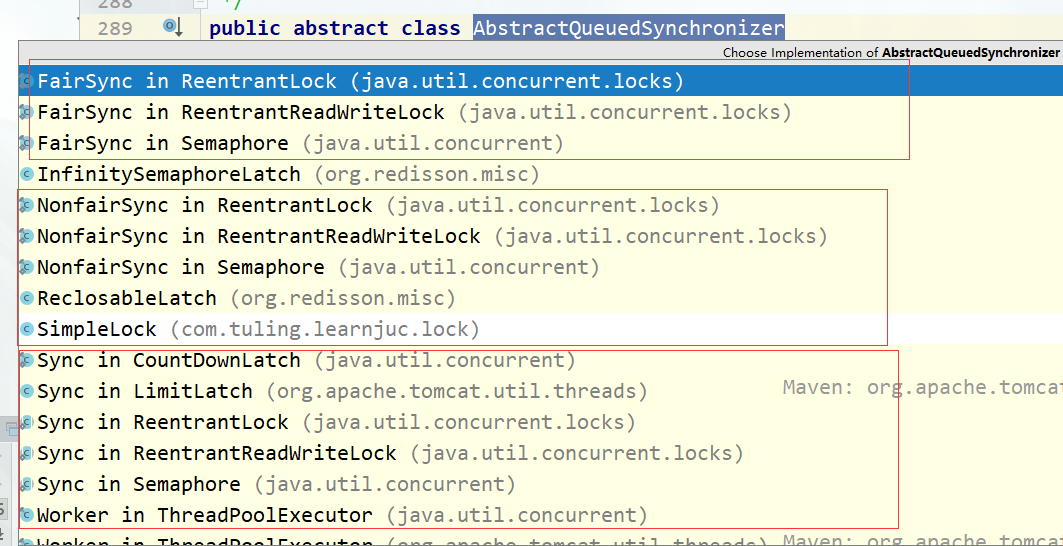
AQS具备的特性:
- 阻塞等待队列
- 共享/独占
- 公平/非公平
- 可重入
- 允许中断
AQS内部维护属性volatile int state
- state表示资源的可用状态
State三种访问方式:
- getState()
- setState()
- compareAndSetState()
AQS定义两种资源共享方式
- Exclusive-独占,只有一个线程能执行,如ReentrantLock
- Share-共享,多个线程可以同时执行,如Semaphore/CountDownLatch
AQS定义两种队列
- 同步等待队列: 主要用于维护获取锁失败时入队的线程
- 条件等待队列: 调用await()的时候会释放锁,然后线程会加入到条件队列,调用signal()唤醒的时候会把条件队列中的线程节点移动到同步队列中,等待再次获得锁
AQS 定义了5个队列中节点状态:
- 值为0,初始化状态,表示当前节点在sync队列中,等待着获取锁。
- CANCELLED,值为1,表示当前的线程被取消;
- SIGNAL,值为-1,表示当前节点的后继节点包含的线程需要运行,也就是unpark;
- CONDITION,值为-2,表示当前节点在等待condition,也就是在condition队列中;
- PROPAGATE,值为-3,表示当前场景下后续的acquireShared能够得以执行;
不同的自定义同步器竞争共享资源的方式也不同。自定义同步器在实现时只需要实现共享资源state的获取与释放方式即可,至于具体线程等待队列的维护(如获取资源失败入队/唤醒出队等),AQS已经在顶层实现好了。自定义同步器实现时主要实现以下几种方法:
- isHeldExclusively():该线程是否正在独占资源。只有用到condition才需要去实现它。
- tryAcquire(int):独占方式。尝试获取资源,成功则返回true,失败则返回false。
- tryRelease(int):独占方式。尝试释放资源,成功则返回true,失败则返回false。
- tryAcquireShared(int):共享方式。尝试获取资源。负数表示失败;0表示成功,但没有剩余可用资源;正数表示成功,且有剩余资源。
- tryReleaseShared(int):共享方式。尝试释放资源,如果释放后允许唤醒后续等待结点返回true,否则返回false。
同步等待队列
AQS当中的同步等待队列也称CLH队列,CLH队列是Craig、Landin、Hagersten三人发明的一种基于双向链表数据结构的队列,是FIFO先进先出线程等待队列,Java中的CLH队列是原CLH队列的一个变种,线程由原自旋机制改为阻塞机制。
AQS 依赖CLH同步队列来完成同步状态的管理:
- 当前线程如果获取同步状态失败时,AQS则会将当前线程已经等待状态等信息构造成一个节点(Node)并将其加入到CLH同步队列,同时会阻塞当前线程
- 当同步状态释放时,会把首节点唤醒(公平锁),使其再次尝试获取同步状态。
- 通过signal或signalAll将条件队列中的节点转移到同步队列。(由条件队列转化为同步队列)
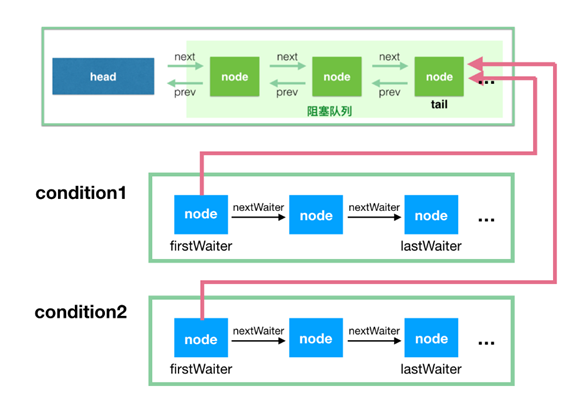
条件等待队列
AQS中条件队列是使用单向列表保存的,用nextWaiter来连接:
- 调用await方法阻塞线程;
- 当前线程存在于同步队列的头结点,调用await方法进行阻塞(从同步队列转化到条件队列)
Condition接口详解
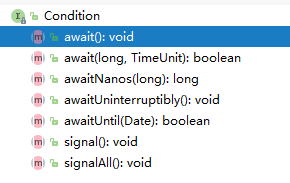
- 调用Condition#await方法会释放当前持有的锁,然后阻塞当前线程,同时向Condition队列尾部添加一个节点,所以调用Condition#await方法的时候必须持有锁。
- 调用Condition#signal方法会将Condition队列的首节点移动到阻塞队列尾部,然后唤醒因调用Condition#await方法而阻塞的线程(唤醒之后这个线程就可以去竞争锁了),所以调用Condition#signal方法的时候必须持有锁,持有锁的线程唤醒被因调用Condition#await方法而阻塞的线程。
等待唤醒机制之await/signal测试
import java.util.concurrent.locks.Condition;
import java.util.concurrent.locks.Lock;
import java.util.concurrent.locks.ReentrantLock;
import lombok.extern.slf4j.Slf4j;
/**
* 等待唤醒机制 await/signal测试
*/
@Slf4j
public class ConditionTest {
public static void main(String[] args) {
Lock lock = new ReentrantLock();
Condition condition = lock.newCondition();
new Thread(() -> {
lock.lock();
try {
log.debug(Thread.currentThread().getName() + " 开始处理任务");
//会释放当前持有的锁,然后阻塞当前线程
condition.await();
log.debug(Thread.currentThread().getName() + " 结束处理任务");
} catch (InterruptedException e) {
e.printStackTrace();
} finally {
lock.unlock();
}
}).start();
new Thread(() -> {
lock.lock();
try {
log.debug(Thread.currentThread().getName() + " 开始处理任务");
Thread.sleep(2000);
//唤醒因调用Condition#await方法而阻塞的线程
condition.signal();
log.debug(Thread.currentThread().getName() + " 结束处理任务");
} catch (Exception e) {
e.printStackTrace();
} finally {
lock.unlock();
}
}).start();
}
}
结果
18:55:50.720 [Thread-0] DEBUG com.yoocar.jucdemo.lock.ConditionTest - Thread-0 开始处理任务
18:55:50.722 [Thread-1] DEBUG com.yoocar.jucdemo.lock.ConditionTest - Thread-1 开始处理任务
18:55:52.737 [Thread-1] DEBUG com.yoocar.jucdemo.lock.ConditionTest - Thread-1 结束处理任务
18:55:52.737 [Thread-0] DEBUG com.yoocar.jucdemo.lock.ConditionTest - Thread-0 结束处理任务
ReentrantLock详解
ReentrantLock是一种基于AQS框架的应用实现,是JDK中的一种线程并发访问的同步手段,它的功能类似于synchronized是一种互斥锁,可以保证线程安全。
相对于 synchronized, ReentrantLock具备如下特点:
- 可中断
- 可以设置超时时间
- 可以设置为公平锁
- 支持多个条件变量
- 与 synchronized 一样,都支持可重入
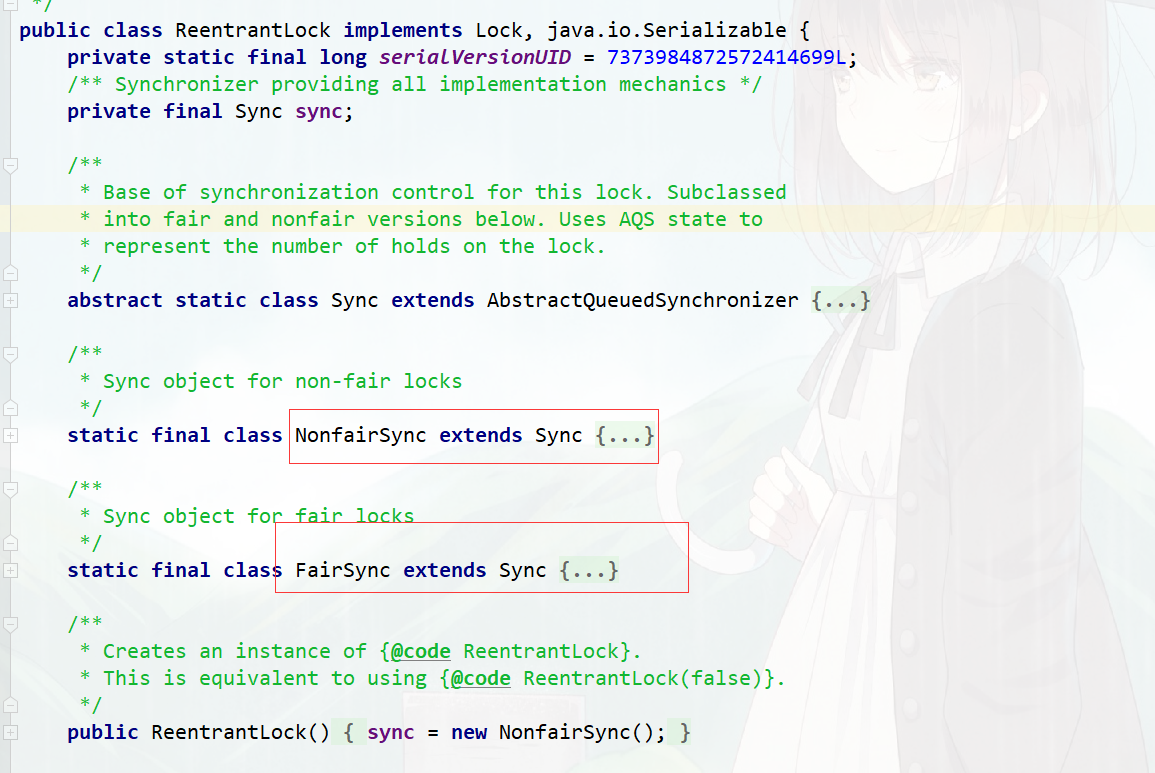
顺便总结了几点synchronized和ReentrantLock的区别:
- synchronized是JVM层次的锁实现,ReentrantLock是JDK层次的锁实现;
- synchronized的锁状态是无法在代码中直接判断的,但是ReentrantLock可以通过ReentrantLock#isLocked判断;
- synchronized是非公平锁,ReentrantLock是可以是公平也可以是非公平的;
- synchronized是不可以被中断的,而ReentrantLock#lockInterruptibly方法是可以被中断的;
- 在发生异常时synchronized会自动释放锁,而ReentrantLock需要开发者在finally块中显示释放锁;
- ReentrantLock获取锁的形式有多种:如立即返回是否成功的tryLock(),以及等待指定时长的获取,更加灵活;
- synchronized在特定的情况下对于已经在等待的线程是后来的线程先获得锁(回顾一下sychronized的唤醒策略),而ReentrantLock对于已经在等待的线程是先来的线程先获得锁;
ReentrantLock的使用
同步执行,类似于synchronized
ReentrantLock lock = new ReentrantLock(); //参数默认false,不公平锁
ReentrantLock lock = new ReentrantLock(true); //公平锁
//加锁
lock.lock();
try {
//临界区
} finally {
// 解锁
lock.unlock();
}
测试
import java.util.concurrent.locks.Lock;
import java.util.concurrent.locks.ReentrantLock;
/**
* 同步执行
*/
public class ReentrantLockDemo {
private static int sum = 0;
private static Lock lock = new ReentrantLock();
public static void main(String[] args) throws InterruptedException {
for (int i = 0; i < 3; i++) {
Thread thread = new Thread(()->{
//加锁
lock.lock();
try {
// 临界区代码
// TODO 业务逻辑:读写操作不能保证线程安全
for (int j = 0; j < 10000; j++) {
sum++;
}
} finally {
// 解锁
lock.unlock();
}
});
thread.start();
}
Thread.sleep(2000);
System.out.println(sum);
}
}
可重入
import java.util.concurrent.locks.ReentrantLock;
import lombok.extern.slf4j.Slf4j;
/**
* 可重入
*/
@Slf4j
public class ReentrantLockDemo2 {
public static ReentrantLock lock = new ReentrantLock();
public static void main(String[] args) {
method1();
}
public static void method1() {
lock.lock();
try {
log.debug("execute method1");
method2();
} finally {
lock.unlock();
}
}
public static void method2() {
lock.lock();
try {
log.debug("execute method2");
method3();
} finally {
lock.unlock();
}
}
public static void method3() {
lock.lock();
try {
log.debug("execute method3");
} finally {
lock.unlock();
}
}
}
可中断
import java.util.concurrent.locks.ReentrantLock;
import lombok.extern.slf4j.Slf4j;
/**
* 可中断
*/
@Slf4j
public class ReentrantLockDemo3 {
public static void main(String[] args) throws InterruptedException {
ReentrantLock lock = new ReentrantLock();
Thread t1 = new Thread(() -> {
log.debug("t1启动...");
try {
lock.lockInterruptibly();
try {
log.debug("t1获得了锁");
} finally {
lock.unlock();
}
} catch (InterruptedException e) {
e.printStackTrace();
log.debug("t1等锁的过程中被中断");
}
}, "t1");
lock.lock();
try {
log.debug("main线程获得了锁");
t1.start();
//先让线程t1执行
Thread.sleep(1000);
t1.interrupt();
log.debug("线程t1执行中断");
} finally {
lock.unlock();
}
}
}
import java.util.concurrent.locks.ReentrantLock;
import lombok.extern.slf4j.Slf4j;
/**
* 可中断
*/
@Slf4j
public class ReentrantLockDemo3 {
public static void main(String[] args) throws InterruptedException {
ReentrantLock lock = new ReentrantLock();
Thread t1 = new Thread(() -> {
log.debug("t1启动...");
try {
lock.lockInterruptibly();
try {
log.debug("t1获得了锁");
} finally {
lock.unlock();
}
} catch (InterruptedException e) {
e.printStackTrace();
log.debug("t1等锁的过程中被中断");
}
}, "t1");
lock.lock();
try {
log.debug("main线程获得了锁");
t1.start();
//先让线程t1执行
Thread.sleep(1000);
t1.interrupt();
log.debug("线程t1执行中断");
} finally {
lock.unlock();
}
}
}
import java.util.concurrent.locks.ReentrantLock;
import lombok.extern.slf4j.Slf4j;
/**
* 可中断
*/
@Slf4j
public class ReentrantLockDemo3 {
public static void main(String[] args) throws InterruptedException {
ReentrantLock lock = new ReentrantLock();
Thread t1 = new Thread(() -> {
log.debug("t1启动...");
try {
lock.lockInterruptibly();
try {
log.debug("t1获得了锁");
} finally {
lock.unlock();
}
} catch (InterruptedException e) {
e.printStackTrace();
log.debug("t1等锁的过程中被中断");
}
}, "t1");
lock.lock();
try {
log.debug("main线程获得了锁");
t1.start();
//先让线程t1执行
Thread.sleep(1000);
t1.interrupt();
log.debug("线程t1执行中断");
} finally {
lock.unlock();
}
}
}
结果
19:05:14.930 [main] DEBUG com.yoocar.jucdemo.lock.ReentrantLockDemo3 - main线程获得了锁
19:05:14.934 [t1] DEBUG com.yoocar.jucdemo.lock.ReentrantLockDemo3 - t1启动...
19:05:15.949 [main] DEBUG com.yoocar.jucdemo.lock.ReentrantLockDemo3 - 线程t1执行中断
19:05:15.950 [t1] DEBUG com.yoocar.jucdemo.lock.ReentrantLockDemo3 - t1等锁的过程中被中断
java.lang.InterruptedException
at java.util.concurrent.locks.AbstractQueuedSynchronizer.doAcquireInterruptibly(AbstractQueuedSynchronizer.java:898)
at java.util.concurrent.locks.AbstractQueuedSynchronizer.acquireInterruptibly(AbstractQueuedSynchronizer.java:1222)
at java.util.concurrent.locks.ReentrantLock.lockInterruptibly(ReentrantLock.java:335)
at com.yoocar.jucdemo.lock.ReentrantLockDemo3.lambda$main$0(ReentrantLockDemo3.java:22)
at java.lang.Thread.run(Thread.java:748)
锁超时
立即失败
import java.util.concurrent.TimeUnit;
import java.util.concurrent.locks.ReentrantLock;
import lombok.extern.slf4j.Slf4j;
/**
* 锁超时
*/
@Slf4j
public class ReentrantLockDemo4 {
public static void main(String[] args) throws InterruptedException {
ReentrantLock lock = new ReentrantLock();
Thread t1 = new Thread(() -> {
log.debug("t1启动...");
// 注意: 即使是设置的公平锁,此方法也会立即返回获取锁成功或失败,公平策略不生效
// if (!lock.tryLock()) {
// log.debug("t1获取锁失败,立即返回false");
// return;
// }
//超时
try {
if (!lock.tryLock(1, TimeUnit.SECONDS)) {
log.debug("等待 1s 后获取锁失败,返回");
return;
}
} catch (InterruptedException e) {
e.printStackTrace();
return;
}
try {
log.debug("t1获得了锁");
} finally {
lock.unlock();
}
}, "t1");
lock.lock();
try {
log.debug("main线程获得了锁");
t1.start();
//先让线程t1执行
Thread.sleep(1000);
} finally {
lock.unlock();
}
}
}
结果
19:07:39.080 [main] DEBUG com.yoocar.jucdemo.lock.ReentrantLockDemo4 - main线程获得了锁
19:07:39.082 [t1] DEBUG com.yoocar.jucdemo.lock.ReentrantLockDemo4 - t1启动...
19:07:40.084 [t1] DEBUG com.yoocar.jucdemo.lock.ReentrantLockDemo4 - 等待 1s 后获取锁失败,返回
超时失败
@Slf4j
public class ReentrantLockDemo4 {
public static void main(String[] args) {
ReentrantLock lock = new ReentrantLock();
Thread t1 = new Thread(() -> {
log.debug("t1启动...");
//超时
try {
if (!lock.tryLock(1, TimeUnit.SECONDS)) {
log.debug("等待 1s 后获取锁失败,返回");
return;
}
} catch (InterruptedException e) {
e.printStackTrace();
return;
}
try {
log.debug("t1获得了锁");
} finally {
lock.unlock();
}
}, "t1");
lock.lock();
try {
log.debug("main线程获得了锁");
t1.start();
//先让线程t1执行
try {
Thread.sleep(2000);
} catch (InterruptedException e) {
e.printStackTrace();
}
} finally {
lock.unlock();
}
}
}
结果
公平锁

ReentrantLock 默认是不公平的
@Slf4j
public class ReentrantLockDemo5 {
public static void main(String[] args) throws InterruptedException {
ReentrantLock lock = new ReentrantLock(true); //公平锁
for (int i = 0; i < 500; i++) {
new Thread(() -> {
lock.lock();
try {
try {
Thread.sleep(10);
} catch (InterruptedException e) {
e.printStackTrace();
}
log.debug(Thread.currentThread().getName() + " running...");
} finally {
lock.unlock();
}
}, "t" + i).start();
}
// 1s 之后去争抢锁
Thread.sleep(1000);
for (int i = 0; i < 500; i++) {
new Thread(() -> {
lock.lock();
try {
log.debug(Thread.currentThread().getName() + " running...");
} finally {
lock.unlock();
}
}, "强行插入" + i).start();
}
}
}
结果

思考:ReentrantLock公平锁和非公平锁的性能谁更高?
条件变量
java.util.concurrent类库中提供Condition类来实现线程之间的协调。调用Condition.await() 方法使线程等待,其他线程调用Condition.signal() 或 Condition.signalAll() 方法唤醒等待的线程。
注意:调用Condition的await()和signal()方法,都必须在lock保护之内。
@Slf4j
public class ReentrantLockDemo6 {
private static ReentrantLock lock = new ReentrantLock();
private static Condition cigCon = lock.newCondition();
private static Condition takeCon = lock.newCondition();
private static boolean hashcig = false;
private static boolean hastakeout = false;
//送烟
public void cigratee(){
lock.lock();
try {
while(!hashcig){
try {
log.debug("没有烟,歇一会");
cigCon.await();
}catch (Exception e){
e.printStackTrace();
}
}
log.debug("有烟了,干活");
}finally {
lock.unlock();
}
}
//送外卖
public void takeout(){
lock.lock();
try {
while(!hastakeout){
try {
log.debug("没有饭,歇一会");
takeCon.await();
}catch (Exception e){
e.printStackTrace();
}
}
log.debug("有饭了,干活");
}finally {
lock.unlock();
}
}
public static void main(String[] args) {
ReentrantLockDemo6 test = new ReentrantLockDemo6();
new Thread(() ->{
test.cigratee();
}).start();
new Thread(() -> {
test.takeout();
}).start();
new Thread(() ->{
lock.lock();
try {
//有烟了
hashcig = true;
//唤醒送烟的等待线程
cigCon.signal();
}finally {
lock.unlock();
}
},"t1").start();
new Thread(() ->{
lock.lock();
try {
//有饭了
hastakeout = true;
//唤醒送饭的等待线程
takeCon.signal();
}finally {
lock.unlock();
}
},"t2").start();
}
}
结果

ReentrantLock源码分析
关注点:
- ReentrantLock加锁解锁的逻辑
- 公平和非公平,可重入锁的实现
- 线程竞争锁失败入队阻塞逻辑和获取锁的线程释放锁唤醒阻塞线程竞争锁的逻辑实现 ( 设计的精髓:并发场景下入队和出队操作)
ReentrantLock加锁逻辑
ReentrantLock reentrantLock=new ReentrantLock();
reentrantLock.lock();
非公平锁的实现
CAS尝试加锁,加锁成功,将State=1
static final class NonfairSync extends Sync {
private static final long serialVersionUID = 7316153563782823691L;
/**
* Performs lock. Try immediate barge, backing up to normal
* acquire on failure.
*/
final void lock() {
//直接CAS
if (compareAndSetState(0, 1))
setExclusiveOwnerThread(Thread.currentThread());
else
acquire(1);
}
protected final boolean tryAcquire(int acquires) {
return nonfairTryAcquire(acquires);
}
}
CAS尝试加锁,加锁失败,入队,阻塞
public final void acquire(int arg) {
if (!tryAcquire(arg) &&
//添加到等待队列
acquireQueued(addWaiter(Node.EXCLUSIVE), arg))
selfInterrupt();
}
tryAcquire
尝试获取锁
protected final boolean tryAcquire(int acquires) {
return nonfairTryAcquire(acquires);
}
final boolean nonfairTryAcquire(int acquires) {
final Thread current = Thread.currentThread();
int c = getState();
if (c == 0) {
if (compareAndSetState(0, acquires)) {
setExclusiveOwnerThread(current);
return true;
}
}
//重入锁,每次+1
else if (current == getExclusiveOwnerThread()) {
int nextc = c + acquires;
if (nextc < 0) // overflow
throw new Error("Maximum lock count exceeded");
setState(nextc);
return true;
}
return false;
}
acquireQueued
Node
static final class Node {
//共享
static final Node SHARED = new Node();
//独占
static final Node EXCLUSIVE = null;
//都是waitStatus的状态
static final int CANCELLED = 1;
static final int SIGNAL = -1;
static final int CONDITION = -2;
static final int PROPAGATE = -3;
volatile int waitStatus;
//链表的前置节点
volatile Node prev;
//链表的后置节点
volatile Node next;
//当前线程
volatile Thread thread;
Node nextWaiter;
final boolean isShared() {
return nextWaiter == SHARED;
}
final Node predecessor() throws NullPointerException {
Node p = prev;
if (p == null)
throw new NullPointerException();
else
return p;
}
Node() { // Used to establish initial head or SHARED marker
}
Node(Thread thread, Node mode) { // Used by addWaiter
this.nextWaiter = mode;
this.thread = thread;
}
Node(Thread thread, int waitStatus) { // Used by Condition
this.waitStatus = waitStatus;
this.thread = thread;
}
}
addWaiter
创建节点并入队
/**
* Creates and enqueues node for current thread and given mode.
*
* @param mode Node.EXCLUSIVE for exclusive, Node.SHARED for shared
* @return the new node
*/
private Node addWaiter(Node mode) {
Node node = new Node(Thread.currentThread(), mode);
//第一次的时候tail=null
Node pred = tail=null;
if (pred != null) {
node.prev = pred;
if (compareAndSetTail(pred, node)) {
pred.next = node;
return node;
}
}
//将node初始化
enq(node);
return node;
}
enq
设置node链表,如果没有链表,则将头结点和尾结点都设置成node
private Node enq(final Node node) {
for (;;) {
Node t = tail;
//没有尾结点
if (t == null) { // Must initialize
//初始化链表,将头结点和尾结点都设置成node
if (compareAndSetHead(new Node()))
tail = head;
} else {
//将node设置到原链表的尾结点后面
node.prev = t;
if (compareAndSetTail(t, node)) {
t.next = node;
return t;
}
}
}
}
acquireQueued
final boolean acquireQueued(final Node node, int arg) {
boolean failed = true;
try {
boolean interrupted = false;
//这里的for循环非常重要,确保node节点可以阻塞和可以中断
for (;;) {
//取到head节点
final Node p = node.predecessor();
if (p == head && tryAcquire(arg)) {
setHead(node);
p.next = null; // help GC
failed = false;
return interrupted;
}
//阻塞
if (shouldParkAfterFailedAcquire(p, node) &&
parkAndCheckInterrupt())
interrupted = true;
}
} finally {
if (failed)
cancelAcquire(node);
}
}
shouldParkAfterFailedAcquire
private static boolean shouldParkAfterFailedAcquire(Node pred, Node node) {
int ws = pred.waitStatus;
//Status=-1是,返回true,表示可以阻塞
if (ws == Node.SIGNAL)
/*
* This node has already set status asking a release
* to signal it, so it can safely park.
*/
return true;
if (ws > 0) {
/*
* Predecessor was cancelled. Skip over predecessors and
* indicate retry.
*/
do {
node.prev = pred = pred.prev;
} while (pred.waitStatus > 0);
pred.next = node;
} else {
/*
* waitStatus must be 0 or PROPAGATE. Indicate that we
* need a signal, but don't park yet. Caller will need to
* retry to make sure it cannot acquire before parking.
*/
//将pred节点的Status设置成-1,表示可以阻塞
compareAndSetWaitStatus(pred, ws, Node.SIGNAL);
}
return false;
}
parkAndCheckInterrupt
private final boolean parkAndCheckInterrupt() {
//挂起当前线程,阻塞线程,内部可以识别中断
LockSupport.park(this);
return Thread.interrupted();
}
ReentrantLock释放锁逻辑
ReentrantLock reentrantLock=new ReentrantLock();
....
reentrantLock.unlock();
unlock()
public void unlock() {
sync.release(1);
}
release
public final boolean release(int arg) {
if (tryRelease(arg)) {
Node h = head;
if (h != null && h.waitStatus != 0)
unparkSuccessor(h);
return true;
}
return false;
}
tryRelease
protected final boolean tryRelease(int releases) {
//c=0
int c = getState() - releases;
if (Thread.currentThread() != getExclusiveOwnerThread())
throw new IllegalMonitorStateException();
boolean free = false;
if (c == 0) {
free = true;
//用于重入锁
setExclusiveOwnerThread(null);
}
//setState=0
setState(c);
return free;
}
unparkSuccessor
private void unparkSuccessor(Node node) {
/*
* If status is negative (i.e., possibly needing signal) try
* to clear in anticipation of signalling. It is OK if this
* fails or if status is changed by waiting thread.
*/
int ws = node.waitStatus;
if (ws < 0)
compareAndSetWaitStatus(node, ws, 0);
/*
* Thread to unpark is held in successor, which is normally
* just the next node. But if cancelled or apparently null,
* traverse backwards from tail to find the actual
* non-cancelled successor.
*/
Node s = node.next;
if (s == null || s.waitStatus > 0) {
s = null;
for (Node t = tail; t != null && t != node; t = t.prev)
if (t.waitStatus <= 0)
s = t;
}
if (s != null)
//唤醒线程
LockSupport.unpark(s.thread);
}
当然其中还有很多链表的操作,后面有时间了再研究
https://www.processon.com/view/link/6191f070079129330ada1209
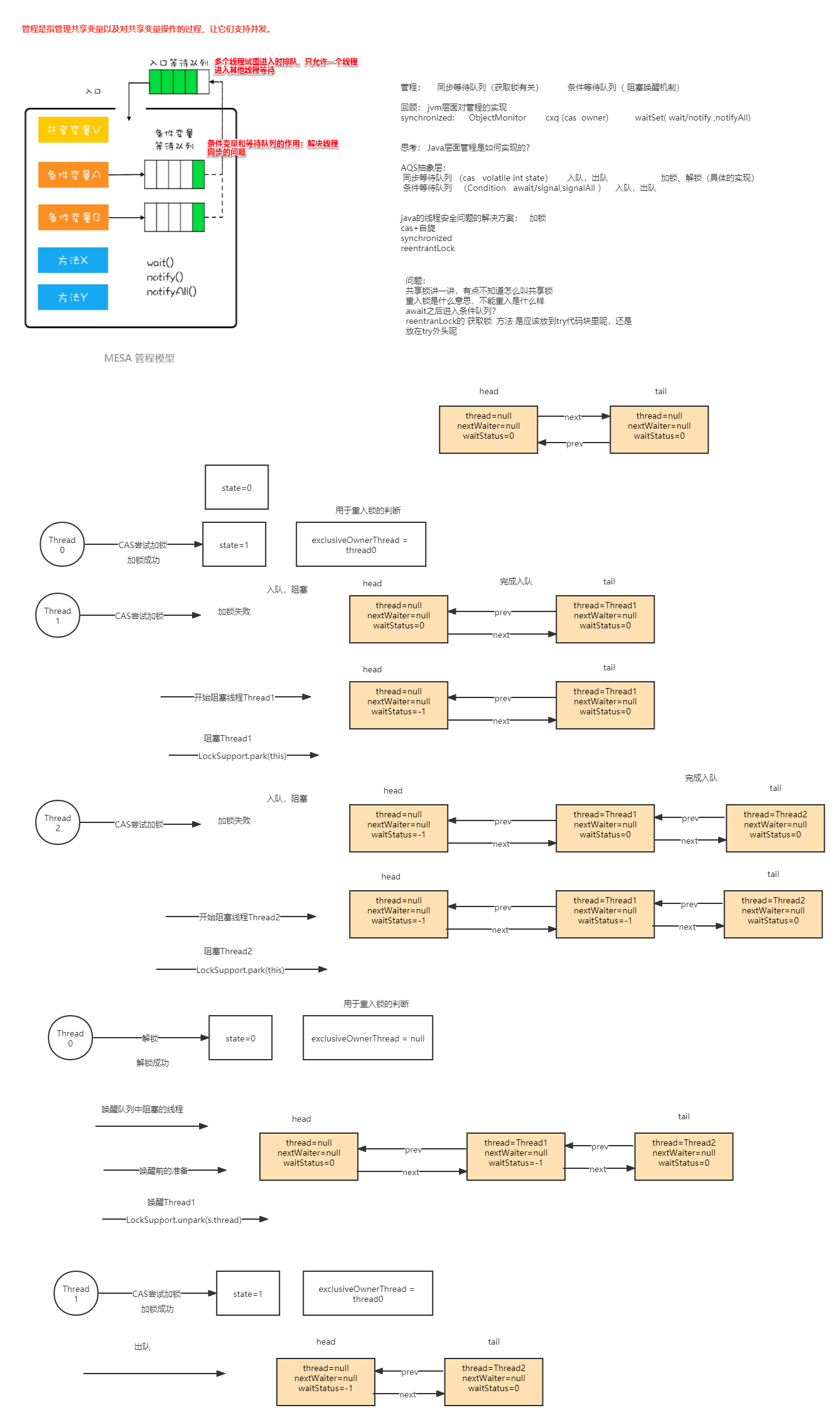


 浙公网安备 33010602011771号
浙公网安备 33010602011771号